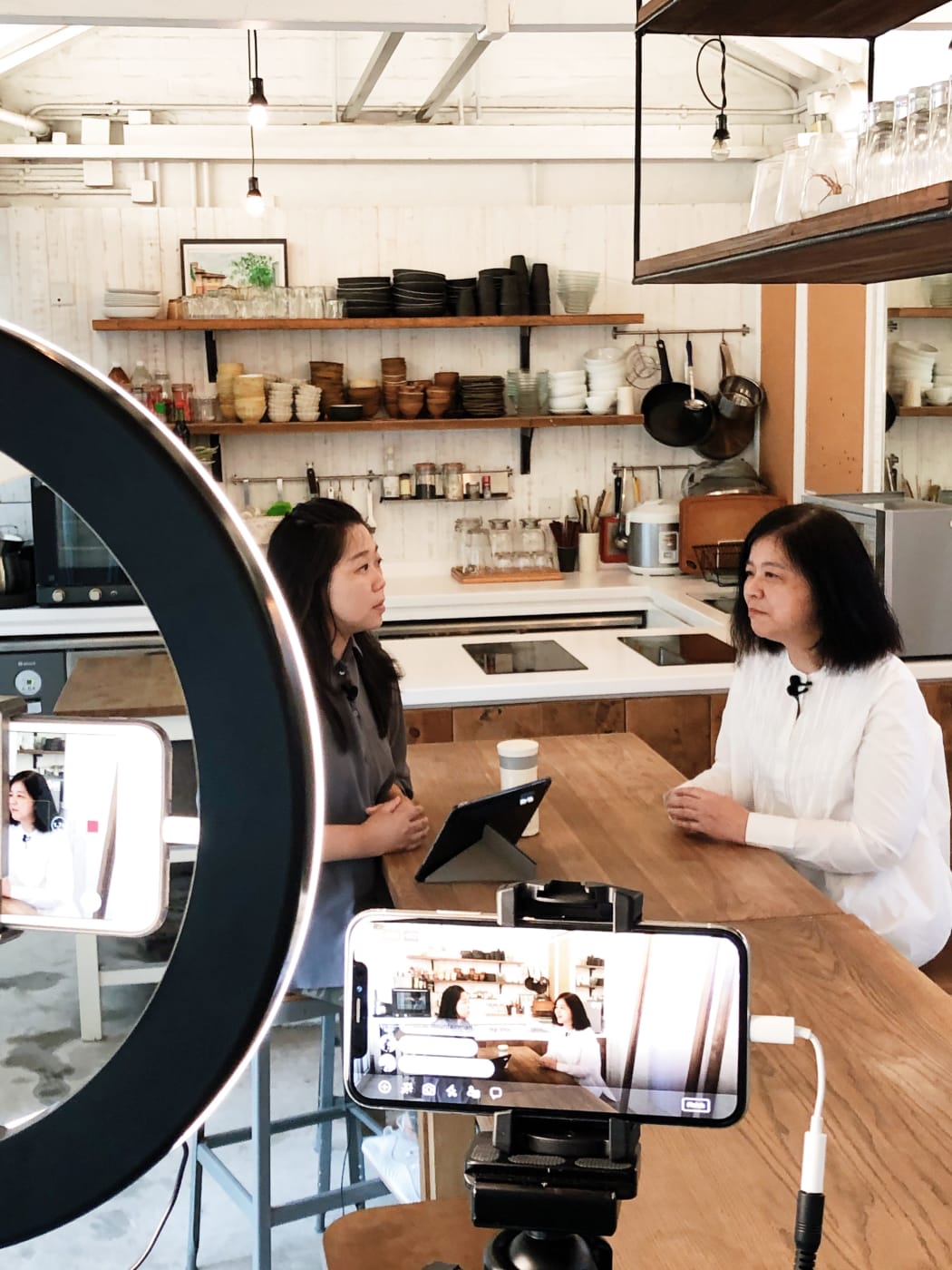
THIS WEEK, ORA-ORA SPEAKS WITH IVY lin from oi! on curatation and community art in hong kong.
Dr. Henrietta Tsui-Leung as Henrietta
Ivy Lin as Ivy
Henrietta: Let me introduce you all to my guest: Ivy Lin. Those who personally know Ivy will know that Ivy has been involved with the arts in Hong Kong since she had graduated from university. This interview is taken place at Oil Street Art Space. I’ve been here quite frequently, for many reasons. Please introduce this location to our audience, starting with the kitchen.
Ivy: You might find it strange that there is a kitchen within an art space, but with it, we actually wanted to introduce the concept that art can be found in our daily lives. We have two traditional galleries within our art space, but we also wanted to organise exhibitions involving experimental artworks. We like to invite artists and friends to join us and create art involving daily life.
Henrietta: This is a very comfortable space.
Ivy: For example, this is a kitchen setting. This is a temporary exhibition. The Stage 2 of the Oil Street Art Space is currently under construction. At this period of time, this kitchen setting becomes a public space which allows visitors to come together and relax.
Henrietta: People can come to this space any time they want.
Ivy: Yes. Exchange activities with the theme of ‘food’ often take place here in this venue. Our next chapter is ‘fair food.’ We hope to encourage a creative way of re-thinking the format of our daily lives.
Henrietta: We were just looking around and I noticed a lot of cups.
Ivy:There are many other plates as well.
Henrietta:So, is there any reason behind this?
Ivy: When we first started this project, we have events where we invited public figures and friends to participate in farming activities in New Territories. They will dig into the soil and use the local soil to make these plates, cups and bowls. We use these utensils during our daily meals as well. The forks and spoons we use are also carved using local lychee wood.
Henrietta: This is very meaningful! You just mentioned how venues such as White Cube have curated exhibitions. The standard of artwork is quite high there. Who is the target audience for your kind of artwork here?
Ivy: There is an exciting story behind this table. We open our doors at 10am every day. People who have finished their morning grocery shopping will come by and sit down to have a chat with each other. At around midday, workers will sit here for shelter and have a cozy lunch with pre-packed lunch boxes. At around 1pm, office workers will come by and have lunch here. They have their sandwiches and will sit on the lawn. If it’s too sunny or if it’s raining, they will come inside for lunch.
Henrietta: How does the setting affect the visitors’ awareness and feelings towards art?
Ivy: Oh, it’s very important! We hope that we can provide a platform for young artists to showcase their works. The kinds of artwork displayed in White Cube for example are usually more experimental and are not easily comprehended by the audience. The artwork displayed here is much more simple. People who came here for lunch usually like to walk around galleries to appreciate more serious artwork. We created a natural flow for visitors to walk between different spaces. When they come back, they’ll find artwork that is easier for them to understand.
Daily activities like eating and relaxing overlap with art. We believe that the daily scenes of life should be related to creativity; both of them are connected. So, we want to discuss this subject matter in this space. We hope to bridge day-to-activities with art and encourage dialogue between the two within this space.
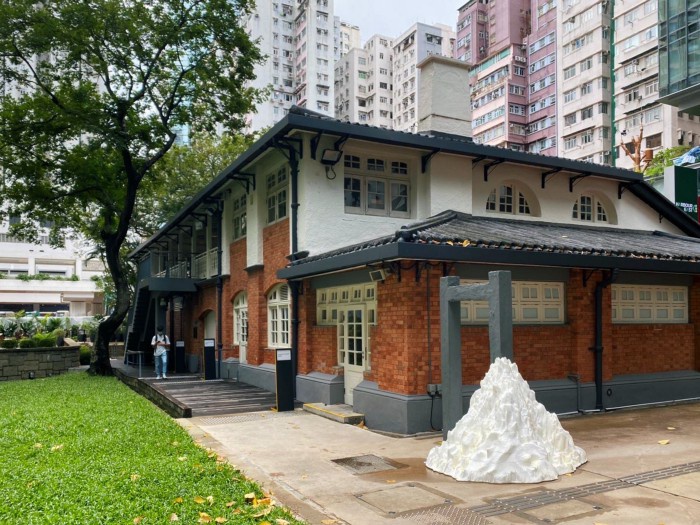
Image: Oil Street Art Space building at North Point (Image courtesy of Ora-Ora)
Ivy: This art space is a historical building that was originally the Royal Hong Kong Yacht Club.
Henrietta: This historical monument is very beautiful.
Ivy: Yes, very beautiful. It is an important landmark on the coastline of Hong Kong Island. The green lawn outside was previously the sea. This building is a landmark which witnessed the development of the coastline for the past 100 years. There is a strong sense of history here. Oil Street Art Space Stage 2 is under construction in the opposite area.
Henrietta: It’s a very large space. I remember you said it’s going to be thirty thousand square feet?
Ivy: More than thirty thousand square feet.
Henrietta: Can you tell us more about your new ideas? Is it going to open during the night as well?
Ivy: Our current and future sites both value public accessibility and our relationship with the community and citizens. We aim to use art and creativity to build closer relationships with them. We had a new idea for the public space to be opened 24 hours a day, which is unprecedented.
Henrietta: So you can enter the public art space anytime you want during the day. You can experience or even have your late night suppers there. Imagine a quiet night in here and cooking in this kitchen…You can come in here to cook an instant ramen.
Ivy: We hope to extend our operation hours even for the indoor areas. We are proposing to open our indoor spaces for 24 hours a day during the weekends as well.
Henrietta: Even the indoor areas are opened for 24 hours! This is amazing.
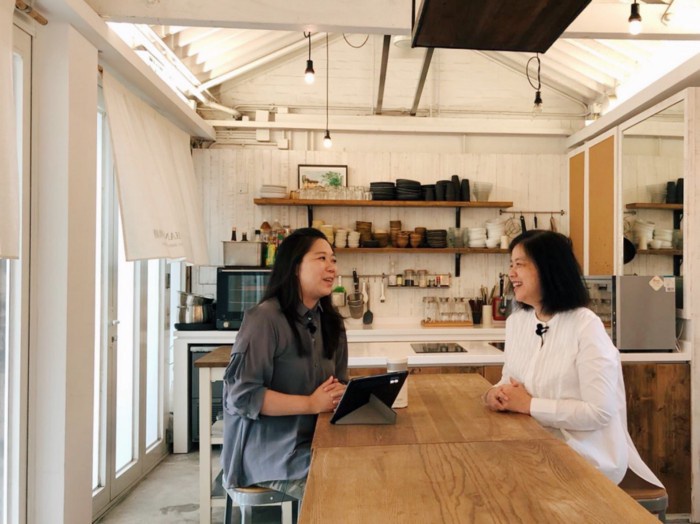
Ivy: I studied Studio Art at the Chinese University of Hong Kong. I am trained as an artist. Of course, the course also includes art history.
Henrietta: Why would you apply for Studio Art? Did you already know you liked art at that age? Did you come from an artistic family?
Ivy: No. I really liked drawing and reading books when I was young.
Henrietta: Did you have drawing lessons when you were young?
Ivy: No. I didn’t have the chance.
Henrietta: So you only got training when you were in university. Why do you think they accepted you?
Ivy: I don’t really know why. I just know that I love drawing and I taught myself how to draw.
Henrietta: Self-taught?
Ivy: Right. I was able to do quite well in activities that didn’t demand creativity. I had been very well-behaved since I was young.
Henrietta: You are able to do well within a set of parameters.
Ivy: I was a prefect at school.
Henrietta: So you are excellent in character and in learning.
Ivy: I excel in anything that requires self-discipline. But this is also why I wanted to study art. I studied art theory, but I didn’t quite like it. If you just sit still and obediently follow the rules, you can do well in art theory. It’s easy to get 100 marks. But then I started thinking, what’s the meaning of this?
Henrietta: Very meaningful.
Ivy: Then when I was in university, I chose to study art. The instructors there teach by example. They won’t guide you to draw stroke by stroke. They will demonstrate the depth of art by example as artists themselves. A lot of times, I had to depend on myself, which I appreciated. In the years that I studied art, I felt very happy. Of course, there were stressful times as well. We needed to complete a lot of projects and had to chase deadlines. But I had a lot of creative freedom. The years of studying art inspired me a lot. It gave me absolute freedom, they were no objective standards, there was no right or wrong, there was no grading. It depends on you to find the right thing. I feel like this is the point of art. There are no jobs for ‘artists’.
Henrietta: There are no jobs for ‘artists’. There’s no market for art practitioners in Hong Kong. There are exhibitions.
Ivy: There are not a lot of vacancies in exhibition-related work. I was lucky that I could participate in some competitions and exhibitions after I graduated university. After applying to be a civil servant and started working in the Art Museum, I felt a little awkward. I am a creator, but I was also responsible for working on collection and research projects and analysing people’s artworks. The identity is a little different from being an artist. While working at the museum, I didn’t feel like I could exercise my creative freedom. There’s an inherent hierarchal structure at the museum and there are a lot of departments there. It requires a high level of teamwork and cooperation. The structure there is different from the one here. The structure here is linear. A lot of concepts are delivered in a top-down way. In museums, we need to collaborate with different departments. The working style can be horizontal, or vertical or diagonal.
Henrietta: So it is more about arts administration.
Ivy: It is similar to my experience in secondary school. It requires rules and discipline. You have to work within the rules.
Henrietta: I understand now.
Ivy: The expectations are different. My superiors told me that curators are gatekeepers, according to English tradition.
Henrietta: Why are they called gatekeepers? I thought the curatorial team is responsible for thinking up a theme for an exhibition, and for sourcing artists and mounting installations. Why are they called gatekeepers?
Ivy: Curators are not only responsible for looking after contemporary art. We are also tasked with taking care of historical artwork and artefacts. We need to compile and organise research, and to find out the time period the artwork belongs to. We also need to manage these artworks, put them in storage and make sure that are kept in good, lasting physical condition. All this involves a rational and calm administration process. Under English tradition, museum curators are often referred to as history or fine art museum curators, rather than for contemporary art museums.
Curators play an important role and have a lot of functions within the museum structure: we educate, we conduct research, we preserve, etc. That’s why are gatekeepers, we uphold the standards of the artworks you see, we make sure that the knowledge is passed on accurately. But the curator in this setting is a little bit different. Even though the name of the role is the same, it is closer to the role of “artistic creator”. While we are still responsible for arts administration, at the same time we have to maintain an intimate relationship with the artist.
Henrietta: Especially because the artist is a living artist.
Ivy: You need to present an artist’s artwork in the best light possible. You have to present the its best side and you have to communicate its value. You have to be close with the artist, you have to understand his creation process, the choices and considerations he made, his feelings, etc. If you have art creation experience, it would help a lot for you to build a close relationship with the artist.
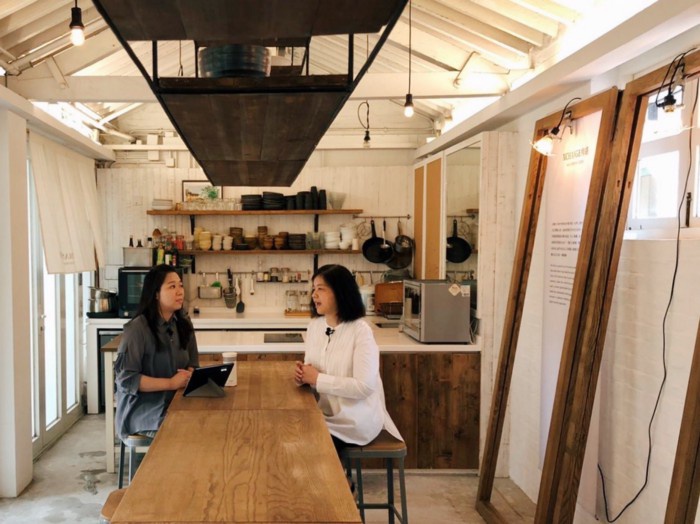
Ivy: There are now less distinctions between disciplines. There are a lot of cross-discipline courses in universities. You need to use different angles and perspectives to look at one issue. Being a curator, you not only have to interact with artists, you also need to be creative in order to discuss art with the artist. Aside from this, curators need to have a vision and have to look outside conventions and traditional scope of art. You have to have understand economics and humanities, for example.
Look at our kitchen. Our artists created the kitchen based on the daily life. When they discussed meals, they looked into environmental issues. When they discussed fair food, they looked into economics. All of the subjects they discussed are present issues that we can all relate to. The practice of contemporary artists is very wide-ranging and broad. As artists, we need to be able to use different types of art. Aside from the traditional easel painting, ink painting, sculpture or ceramics, there is also the emergence of other mediums.
Henrietta: It’s more about the concept, rather than the final product itself.
Ivy: Yes. Curators don’t create art. They have someone that they care about. I should put it this way. They have friends who create certain types of artwork, something that they are passionate about. Curators have a team around them, or I should say a group, who share different ideas and thoughts with each other. They have different roles. I always describe curators as movie directors. They need to have good actors for their films.
Henrietta: Curators usually follow a certain group of artists, and they always use the same artists, who are experts in their own genres, for their shows.
Ivy: Curators have stories they want to tell. They need a good script. They need people to write their scripts, to write the lines. They also need people to help with the lighting. A team is required for each curatorial project. The curator’s role is to orchestrate the team, to instruct them what they need to do. To do this well, they need experience and knowledge. They need to know their staff well, and to allocate work properly. They are leaders, their job is to give their staff instructions and hints so that they can tell a story properly. The staff may sometimes go overboard with their storytelling, but it’s okay, because the curator will reel them back in and give them encouragement to do better. This will elevate the project.
Curators need to have good communicative skills, they need to be effective leaders. They need curiosity, to have a story they want to tell. They have to know they can’t work alone, they need a whole team for support.
Henrietta: I always see you walking around here.
Ivy: When I was working at the Art Museum, I was dressed very properly.
Henrietta: But no one could see you! You were working in the offices, right?
Ivy: I wore dresses and high heels. But here, I need to blend in so I have to make changes to my outfit styles. I no longer wear high heels. If I need to go to the toilet here, I have to walk down several flights of stairs to reach the toilet.
Henrietta: You have to walk through the lawn as well.
Ivy: Yes, I have to trek through the outdoor area before I could reach the toilet. This space is really special, it is in the street corner.
Henrietta: This Oil Street Art Space is in North Point.
Ivy: It is in the intersection between Oil Street and Electric Street. It is just a building in the street corner. Our entrance is strange. We have two entrances, one is located on Oil Street, one on Electric Road. Once we open our doors in the morning, people will be walking in and out. There is a strong feeling of closeness and intimacy for people who want to look at art here. Once you walk into the lawn, you can see creative artwork. You can see the art when you are walking along the streets already.
Henrietta: I agree.

Ivy: This is a public space. There is no entrance fee, and you don’t have to make bookings. You can come in anytime you want. This is a place where friends meet up and have a chat or have a meeting. People come in here to take graduation pictures or sit down and relax after afternoon tea.
Henrietta: In other words, you would not kick me out if I organised a meeting with my colleagues here?
Ivy: No way! This is a space that allows for freedom of movement. We want to create an open space. Not only in the physical sense, but also spiritually. You can enter and exit anytime you want without restrictions. We don’t have turnstiles that measure the number of people traversing our entrance. We don’t have such restrictions. We also don’t have rigid rules.
We had rules before, for example, in the early days of operation, we had a security guard who was a police officer, and he was given a uniform with badges and labels. When we saw the uniform, we told him to not wear it anymore, and to wear a simple t-shirt instead. The guard responded angrily, “No one would be afraid of me then!” We told him, “We never want our visitors to fear us. We want people to be happy, we just don’t want accidents to happen. When you see children running around, you can just tell them to slow down and be careful. We just want you to protect them, not to let them fear you.”
Henrietta: One good thing about this Oil Street Art Space is that there are no collection items. You have exhibition items which of course you still need to be careful around, but there are no artefacts of hundreds or thousands years worth of historical value.
Ivy: Our building is a historical monument which we still need to protect!
Henrietta: Right! This is a Grade II historical building!
Ivy: Visitors here are well-behaved. Our staff respects our visitors, we don’t tell you what not to do. We have rules labelled on our walls, of course. You can walk across our lawns, but we will remind you to take care of the grass. We have a small farm here, and visitors can feel free to take our crops back home. We will teach you how to cut the crops in the correct manner so that they can continue to grow properly.
Henrietta: Don’t tear them away.
Ivy: Yes. We talk to our visitors in a polite, friendly way. Visitors will feel that they are respected, and in turn, they will respect us and our property as well. They won’t dispose their rubbish casually. They won’t make a mess on our tables when having their meals here. Sometimes, they would even help us clean the tables.
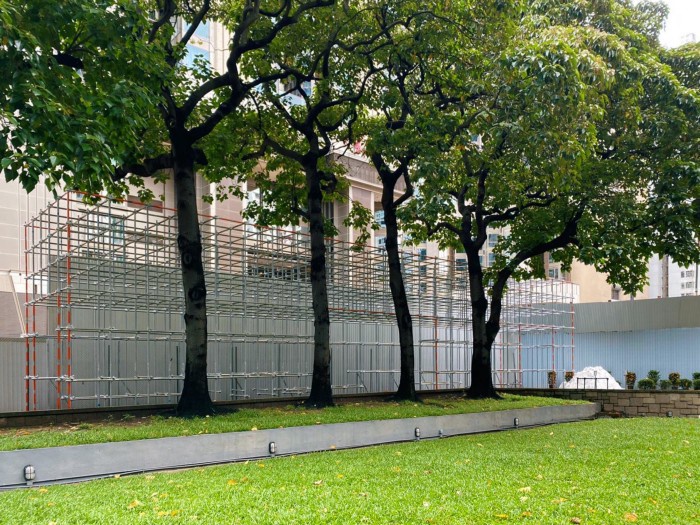
Let me tell you a story: there’s a homeless man who in the past would come by to our site quite frequently. At around 2pm every day, he’ll collect lunch boxes from different restaurants and would come by. One day, our staff here prepared some food and shared it with the man. He was very happy. He opened his own lunchbox and told our staff, “I seem to have a hearty lunch today. Would you want some?” If a homeless man can be so generous and willing to share, it must mean that our staff has his trust. He must have had felt safe and comfortable being here, and felt that he wouldn’t be discriminated. He felt a sense of belonging.
Henrietta: On this note, we can talk about how much you care about the community. It seems to me that the Art Space cares a lot of about community art, or art in community. Visitors don’t have to meet any thresholds to come in here. Homeless people, people from expensive residential areas, students who come in after school, are all welcomed here. I would like to know your opinion on community art and art in community? Is there a difference between the two? When I was young, I don’t feel like I had gained from community art. My parents paid for art lessons. I would like to know your view on community art.
Ivy: I have a lot of friends who are engaged in community art or art in community related work. Since the 90s in Hong Kong, we had been thinking how to bring art from museums into the community. For example, we would display artwork in public art spaces, like civic centres, libraries and shopping malls. We wanted to bring museum-quality artwork into the community, so that more people can gain access to them. Another group of friends would take the route to bring art to those who are physically disabled, with visual impairment or hearing loss, and allow them to have access to art and create art.
Henrietta: Art in hospitals.
Ivy: Yes. They are working hard to make this possible. There are many different groups of people who are engaging in making community artwork. Through the Oil Street Art Space, we hope to use another way to promote community art. This is a public space, and we value our relationship with the community, we hope to create “commons” through different projects.
Henrietta: Commons.
Ivy: In Chinese, “commons’ means a collective.
Henrietta: A collective.
Ivy: Yes. We try to engage people through different means. When people are together and are about to get together, they would build connections to develop the same goal. Through developing this goal, they would start to build similar values.
Henrietta: Understood. With a blink of an eye, we’ve already talked for an hour. Thank you for your time. Is there anything you’d want to talk about that we hadn’t discussed yet?
Ivy: I feel like I’ve said too much already.
Henrietta: No way.
Ivy: I feel like we need to try and experience more of different formats of art. One thing great about art is that experience is more important than talk. You can absorb so much more through experience, it is not something that words or speech can ever compare to. So if you have the time and chance, do come here and experience for yourself!
Henrietta: Thank you so much, Ivy.
ABOUT ORA-ORA LIVE
Each week, Ora-Ora will speak with various members of the art community — including artists, curators, academics and other professionals working in the cultural sector — to address topics of interest related but not limited to Hong Kong’s art and cultural scene. The series aims to be an outlet for creativity and a means to connect with peers who share similar interests. The episodes will also available live on Ora-Ora’s Instagram (@galerieoraora), Facebook (Galerie Ora-Ora) and later on Ora-Ora’s YouTube channel.